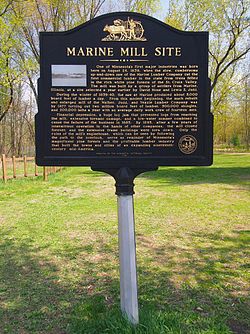
Marine on St. Croix or Marine on Saint Croix is a city in Washington County, Minnesota, United States. The population was 689 at the 2010 census. It was founded in 1839 as Marine Mills. The city was the site of the first commercial sawmill on the St. Croix River. A substantial portion of the city is listed as a historic district on the National Register of Historic Places and by the state of Minnesota.

Saint Anthony Falls, or the Falls of Saint Anthony located at the northeastern edge of downtown Minneapolis, Minnesota, is the only natural major waterfall on the Mississippi River. Throughout the mid-to-late 1800’s, various dams were built atop the east and west faces of the falls to support the milling industry that spurred the growth of the city of Minneapolis. In 1880, the central face of the falls was reinforced with a sloping timber apron to stop the upstream erosion of the falls. In the 1950s, the apron was rebuilt with concrete, which makes up the most visible portion of the falls today. A series of locks were constructed in the 1950s and 1960s to extend navigation to points upstream.

The St. Croix River is a tributary of the Mississippi River, approximately 169 miles (272 km) long, in the U.S. states of Wisconsin and Minnesota. The lower 125 miles (201 km) of the river form the border between Wisconsin and Minnesota. The river is a National Scenic Riverway under the protection of the National Park Service. A hydroelectric plant at the Saint Croix Falls Dam supplies power to the Minneapolis–St. Paul metropolitan area.

Wild River State Park is a state park of Minnesota, United States, curving along 18 miles (29 km) of the St. Croix River. This long, narrow park is shaped somewhat like a sideways 'S', with development largely concentrated in the lower third. The remote upper sections flank the mouth of a tributary called the Sunrise River. The park is managed to provide quieter, more nature-oriented recreation as a counterpoint to the busier William O'Brien and Interstate State Parks downstream.

Interstate Park comprises two adjacent state parks on the Minnesota–Wisconsin border, both named Interstate State Park. They straddle the Dalles of the St. Croix River, a deep basalt gorge with glacial potholes and other rock formations. The Wisconsin park is 1,330 acres (538 ha) and the Minnesota park is 298 acres (121 ha). The towns of Taylors Falls, Minnesota and St. Croix Falls, Wisconsin are adjacent to the park. Interstate Park is within the Saint Croix National Scenic Riverway and the Ice Age National Scientific Reserve. The western terminus of the Ice Age National Scenic Trail is on the Wisconsin side. On the Minnesota side, two areas contain National Park Service rustic style buildings and structures that are listed on the National Register of Historic Places.

St. Croix State Park is a state park in Pine County, Minnesota, USA. The park follows the shore of the St. Croix River for 21 miles (34 km) and contains the last 7 miles (11 km) of the Kettle River. At 33,895 acres (13,717 ha) it is the largest Minnesota state park. It was developed as a Recreational Demonstration Area in the 1930s, and is one of the finest surviving properties of this type in the nation. 164 structures built by the Civilian Conservation Corps and the Works Progress Administration survive, the largest collection of New Deal projects in Minnesota. As a historic district they were listed on the National Register of Historic Places and proclaimed a National Historic Landmark in 1997.

The St. Croix Boom Site is a historic and scenic wayside on the St. Croix River in Stillwater Township, Minnesota, United States. It commemorates the location of a critical log boom where, from 1856 to 1914, timber from upriver was sorted and stored before being dispatched to sawmills downstream. The site was developed as a roadside park along Minnesota State Highway 95 in the 1930s. In 1966 it was designated a National Historic Landmark for its national significance in the theme of industry. It was nominated for being the earliest, most important, and longest serving of the log storage and handling operations that supported Minnesota's major logging industry. Virtually no traces remain of the site's original buildings and structures.

The Captain Austin Jenks House is a historic house in Stillwater, Minnesota, United States, built in 1871. Austin Jenks was a prominent businessman and river pilot involved in timber rafting on the Mississippi and St. Croix Rivers. The house was listed on the National Register of Historic Places in 1982 for having local significance in the themes of architecture, industry, and transportation. It was nominated for its association with Jenks and the importance of water transportation to the region's foundational lumber industry.

This is a list of the National Register of Historic Places listings in Washington County, Minnesota. It is intended to be a complete list of the properties and districts on the National Register of Historic Places in Washington County, Minnesota, United States. The locations of National Register properties and districts for which the latitude and longitude coordinates are included below, may be seen in an online map.
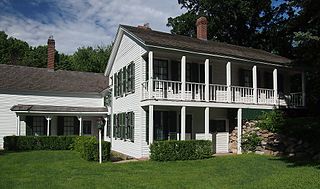
The Ames–Florida–Stork House is a historic house museum in Rockford, Minnesota, United States, on the Crow River. The house was built in 1856 by New England immigrants George F. Ames and his brother-in-law Joel Florida. Ames and Florida came to Minnesota from northern Illinois by steamship. On the steamship, they met Guilford George, a master carpenter and millwright. The three men formed a partnership and established the community of Rockford clustered around a sawmill and a gristmill.
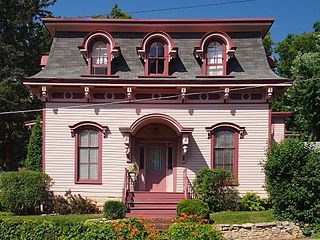
The Ivory McKusick House is a historic house in Stillwater, Minnesota, United States, completed in 1872 for Ivory McKusick (1827–1906). It was listed on the National Register of Historic Places in 1982 for having local significance in the themes of architecture and commerce. It was nominated as a striking example of Second Empire architecture in the region and for its associations with a notable family in early Stillwater. McKusick had built his wealth via the lumber industry and government contracts during the Civil War. His older brother John had helped establish the first sawmill in the vicinity in 1843, named and platted the community that grew around it after his hometown in Maine, and served as its first mayor.

The Albert Lammers House is a historic house in Stillwater, Minnesota, United States, built circa 1893. It was listed on the National Register of Historic Places in 1982 for having local significance in the themes of architecture and industry. It was nominated for its association with a local family that expanded Stillwater's lumber interests into northwest Minnesota, and as the city's leading example of Queen Anne architecture.

The Roscoe Hersey House is a historic house in Stillwater, Minnesota, United States, built 1879–1880. It was designed by architect George W. Orff in a mix of Eastlake and early Queen Anne style. Roscoe Hersey (?1841–1906) was a key figure in Stillwater's lumber and mercantile development, the son and local representative of Isaac Staples' Maine-based business partner Samuel F. Hersey. The house was listed on the National Register of Historic Places in 1982 for having local significance in the themes of architecture, commerce, and industry. It was nominated for its embodiment of the commercial success of the Hersey–Staples partnership, the ties between the St. Croix Valley and Bangor, Maine, and the peak of Stillwater's lumber industry.

The Point Douglas–St. Louis River Road Bridge, built in 1865, is the second oldest known stone arch bridge in the state of Minnesota after Sibley's Ferry Bridge in Mendota, which was built in 1864. It was constructed in Stillwater Township to carry the Point Douglas to Superior Military Road over Brown's Creek. The bridge was listed on the National Register of Historic Places in 1975 for having local significance in the themes of engineering and transportation. It was nominated as an example of stone engineering and as a remnant of Minnesota's early government roads.
Arcola is an unincorporated community in May Township, Washington County, Minnesota, United States. Arcola is located in the southeast part of May Township along State Highway 95. The northeast part of Stillwater Township is also in the immediate area. Nearby places include Stillwater and Marine on St. Croix.

The William Sauntry House and Recreation Hall is a historic property in Stillwater, Minnesota, United States, consisting of a late-nineteenth-century house and a 1902 addition styled after a Moorish palace. It was listed on the National Register of Historic Places in 1982 for its local significance in the themes of architecture and industry. It was nominated for its association with prosperous local lumberman William Sauntry (1845–1914) and for its fanciful recreation hall, one of Minnesota's best examples of a folly and a rare use of Moorish Revival architecture. Now in separate ownership, the recreation hall has been restored as a private home while the William Sauntry Mansion operates as a bed and breakfast.
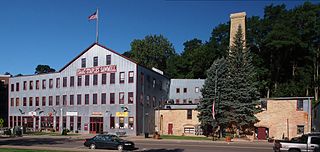
Isaac Staples' Sawmill is a historic industrial property in Stillwater, Minnesota, United States, consisting of an 1850 stone powerhouse and a 1900 metal-clad factory. The property was listed on the National Register of Historic Places as St. Croix Lumber Mills—Stillwater Manufacturing Company in 1982 for its local significance in the theme of industry. It was nominated because the powerhouse is the only surviving industrial building associated with Isaac Staples (1816–1898), a major figure in Minnesota's early commercial development. The property now operates as a shopping mall with upper level apartments.

Arcola Mills is a historic house in the unincorporated community of Arcola, Minnesota, United States. Built in 1847, it is considered the third-oldest and largest all-wood-frame house still standing in Minnesota. It was the home of brothers Martin and John Mower, who established one of the first sawmills on the St. Croix River and the community around it. The house and the remnants of the nearby mill were listed on the National Register of Historic Places in 1980 as the John and Martin Mower House and Arcola Mill Site for having local significance in the themes of architecture, exploration/settlement, and industry. The property was nominated as an "excellent example" of Greek Revival architecture and for its association with the region's early settlement and lumber industry. The property now operates as a non-profit event and education center.
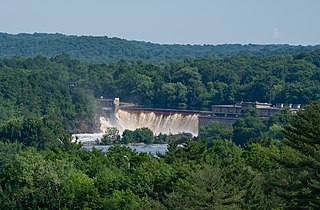
Saint Croix Falls Dam, also known as St. Croix Falls Dam, is a hydroelectric dam on the St. Croix River between St. Croix Falls, Wisconsin and Taylors Falls, Minnesota. The only hydroelectric dam on the St. Croix River, it is operated by Xcel Energy.
The Pas Lumber Company was a forestry company that owned and operated several sawmills and logging operations in Manitoba, Saskatchewan, and British Columbia.
